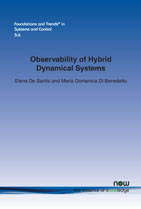Observability of Hybrid Dynamical Systems
By Elena De Santis, University of L’Aquila, Italy, elena.desantis@univaq.it | Maria Domenica Di Benedetto, University of L’Aquila, Italy, mariadomenica.dibenedetto@univaq.it
Abstract
Hybrid systems, that is, heterogeneous systems that include discrete and continuous time subsystems, have been used to model applications in automotive such as engine, brake, and stability control, as well as air traffic control and manufacturing plant control. Because of their generality (they include as special cases continuous and discrete systems), deriving rigorous controller synthesis procedures is difficult. The most effective hybrid control algorithms are based on full state feedback. However, in most cases, only partial information about the internal state of the hybrid plant can be measured. Observability and detectability are concepts of fundamental importance that establish the conditions for reconstruction of the state of a system and have been thoroughly investigated in the continuous and discrete domain but not as systematically for hybrid systems. Hybrid systems’ observability involves both the discrete structure and the continuous dynamics of the system. A hybrid system is said to be observable when it is possible to reconstruct the discrete as well as the continuous state of the system from the observed output information. This paper reviews and places in context how the continuous and the discrete dynamics, as well as their interactions, intervene in the observability property of a quite general class of hybrid systems: linear hybrid systems called H−systems. Our specific objective is to show how the hybrid characteristics of the system come into play and give rise to particular aspects and properties that do not simply generalize the ones that are well-known for traditional dynamical systems. This paper intends to provide a tutorial approach to hybrid systems observability in its various forms to students in control and its application as well as to practitioners in the field.
Observability of Hybrid Dynamical Systems
Hybrid systems have many applications in automotive, such as engine, brake and stability control, air traffic control and manufacturing plant control. The most effective hybrid control algorithms are based on full state feedback. However, in most cases, only partial information about the internal state of the hybrid plant can be measured. Observability is of fundamental importance to establish the conditions for reconstruction of the state of a system and has been thoroughly investigated in the continuous and discrete domain but not for hybrid systems.
Written in a tutorial style, this monograph reviews and places in context how the continuous and the discrete dynamics, as well as their interactions, intervene in the observability property of a quite general class of hybrid systems: linear hybrid systems called H−systems. It provides a tutorial on hybrid systems observability in its various forms to students in control and its application as well as to practitioners in the field.
